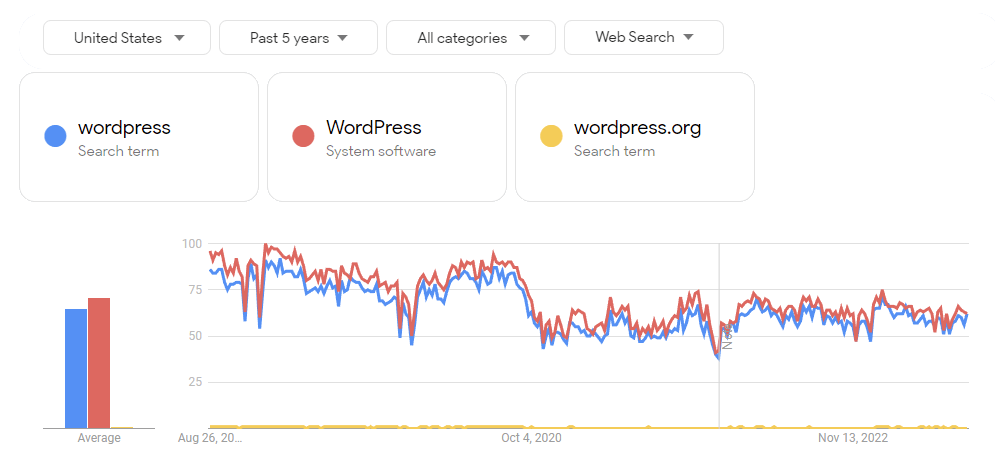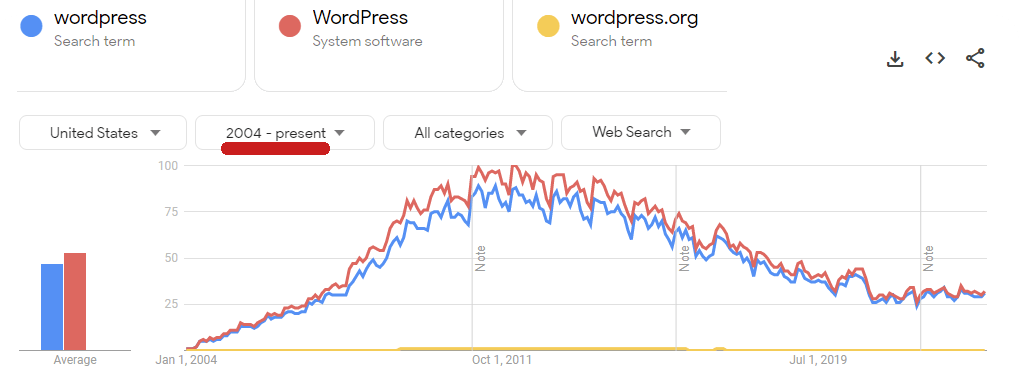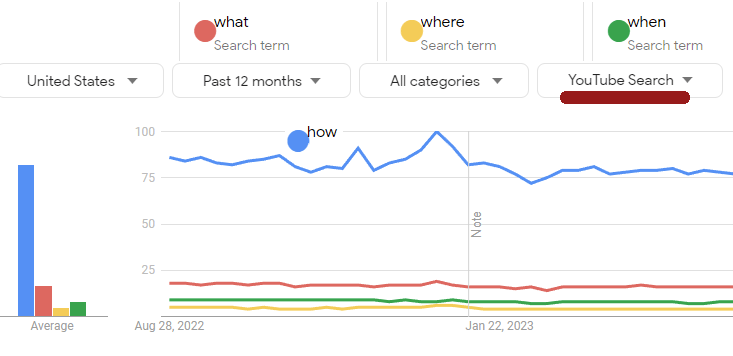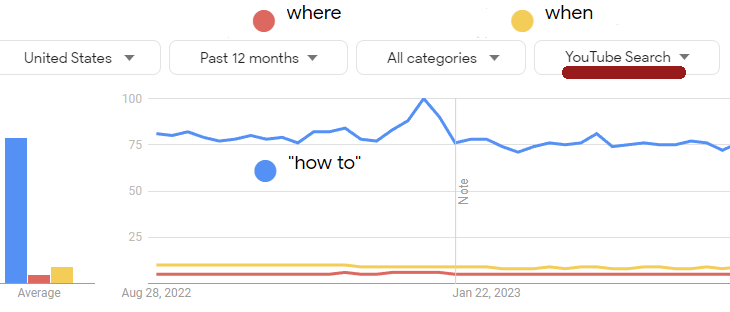Google Trends is a Google tool that offers a wealth of information that is useful for SEO and content creation.
From real-time search trends to related queries and category insights, Google Trends offers marketers plenty of opportunities to hone their strategy and optimize for better performance.
This article will act as an in-depth guide to Google Trends, covering everything you need to know to leverage it for SEO and content marketing.
You’ll learn what it is, how it’s different from other keyword tools, and what methods you can use to get the most out of Google Trends, so you can grow your traffic and get ahead.
Let’s get started.
What Is Google Trends?
Google Trends is a tool for analyzing search queries that shows search trends over a period of time, depicted in a graph.
It offers the ability to compare up to five keyword search terms and to tune the results by geographic location, topic, time period, and search surface (image, news, shopping, and video).
There are four selectable ways to customize the keyword data:
- Geographic location (by individual country or worldwide).
- Topic categories (25 categories plus all categories simultaneously).
- Four different search surfaces (image, news, shopping, YouTube).
- Time.
Time-Based Data
Keyword search trends can further be segmented by the following eight time settings:
- The past hour.
- Past four hours.
- Past day.
- Past seven days.
- Past 30 days.
- Past 90 days.
- Past five years.
- 2004 – present.
How Is Google Trends Data Different From Keyword Search Volumes?
Google Trends is different from third-party keyword research tools in that it lacks keyword search volume data.
It shows the number of search queries made in percentages on a scale of 0 to 100.
Third-party paid SEO tools do show keyword volumes, but they are only estimates.
Generally, third-party reporting tools purchase data from other providers and then create statistical estimates based on that data. The data providers tend to be software companies that collect anonymous search data from their users.
Google Trends data is derived from a sampling of Google’s actual search data, making it the most accurate keyword search data available. Google Trends uses sampling because the actual volume of data numbers is in the billions and is too much to process.
However, Google reassures that the sampling is representative of actual search volume.
Google explains:
“While only a sample of Google searches are used in Google Trends, this is sufficient because we handle billions of searches per day.
Providing access to the entire data set would be too large to process quickly.
By sampling data, we can look at a dataset representative of all Google searches, while finding insights that can be processed within minutes of an event happening in the real world.”
Although Google Trends doesn’t provide keyword volume data, the tool does provide keyword volume data expressed as a percentage, with 100% representing the highest amount of traffic for the given period of time.
That percentage data can be compared with other keywords with known search volumes.
Known search volumes can be obtained by selecting keyword phrases from Google’s trending searches report, which can itself be tuned to specific geographic areas.
Thus, comparing keywords from the trending searches report against those with unknown search volumes will show an accurate representation of actual keyword volume.
How Do I Find Trending Items On Google Trends?
There are two ways to identify trending searches: through Google’s “trending now” webpage and through the Google Trends Explore tool.
Trending Now
Trending now shows the top twenty daily search trends for the current day.
One can click a navigation button to see realtime search trends:
Next, one can select the appropriate country:
 Screenshot from Google Trends, August 2023
Screenshot from Google Trends, August 2023Then select the appropriate category:
 Screenshot from Google Trends, August 2023
Screenshot from Google Trends, August 2023The available categories to choose from are:
- Business.
- Entertainment.
- Health.
- Sci/Tech.
- Sports.
- Top Stories.
Trending now shows actual top trending keywords. The keywords that are displayed are selected by the Google Trends algorithm.
Explore Google Trends By Time
The second way to find trending keywords is to use the Explore Google Trends tool and set the time period to something relatively recent.
The best time periods to select in order to explore trending searches are:
- The past hour.
- Past four hours.
- Past day.
- Past seven days.
 Screenshot from Google Trends, August 2023
Screenshot from Google Trends, August 2023Something to keep in mind with this second method is that one has to select keywords to explore.
This method will show whether or not those keywords are trending.
How To Use Google Trends For SEO & Marketing
There are many ways to manipulate the various filters to extract actionable search query data.
One can even use Google Trends to discover new keyword phrases to target.
1. Use Google Trends Search Operators
Google Trends responds to search operators, which change the data that is shown.
There are four search operators:
- Quotation marks: ” ”
Usage: “keyword1 keyword2”
This shows keyword data for exact match of the keywords in the same order included within the quotation marks. The above example shows data exclusively for keyword1 keyword2. - Plus sign: +
Usage: keyword1 + keyword2
This shows keyword data for search phrases with one or the other keyword. The above example will show data for keyword1 or keyword2. - Minus sign: –
Usage: keyword1 -keyword2
This shows searches for keyword phrases that include the given keyword, but exclude phrases containing the keyword indicated with the minus sign. The above example will show results for all keyword phrases that include the word keyword1 but do not contain keyword2. - No Search Operators
Usage: keyword1 keyword2
Using no search operators shows search interest in keyword phrases that contain the given keywords in any order.
Related: How To Do Keyword Research For SEO
2. Discover Insights From Time-based Trends
There are two general ways to look at the keyword data: stretched across over longer periods of time and viewing search interest by shorter time periods.
Long Period Trends
You can set Google Trends to show you the traffic trends stretching back to 2004. This is valuable for showing you the audience trends.
- Upward long-term trends: If a trend is consistently going up, this means you need to focus energy on creating content for this trend.
- Downward long-term trends: If the trend line is steadily moving down, it may signal that audience content consumption is changing.
- Spikes that vary with regularity: Spikes in searches that come in regular intervals may indicate seasonal patterns to search queries.
For example, review this five-year trend for WordPress the search term, WordPress the software, and WordPress.org:
 Screenshot from Google Trends, August 2023
Screenshot from Google Trends, August 2023There’s a clear downward trend for WordPress in two variations, while the third keyword, WordPress.org, has low search volume overall.
The downward trend is more pronounced when viewed from a longer period than five years:
 Screenshot from Google Trends, August 2023
Screenshot from Google Trends, August 2023The downward trend extends to related phrases such as:
- WordPress themes.
- WordPress plugin.
- WordPress hosting.
There are many reasons why search trends go down. It can be that people have lost interest, the interest went somewhere else, or the trend is obsolete.
The digital camera product category is a good example of a downward spiral caused by a product losing search interest because another product disrupted demand.
- The digital camera caused the downturn in searches for traditional analog cameras.
- The iPhone started the downward spiral of the digital camera.
Knowing which way the wind is blowing could help a content marketer or publisher understand when it’s time to bail on a topic or product category and to pivot to upward-trending ones.
Related: Content Marketing: The Ultimate Beginner’s Guide
3. Related Topics And Queries
Google Trends has two great features, one called “related topics” and the other called “related queries.”
Topics
Related topics show up when investigating one keyword phrase. It doesn’t show when comparing multiple keyword phrases.
 Screenshot from Google Trends, August 2023
Screenshot from Google Trends, August 2023Related topics are search queries that share a concept.
Identifying related topics that are trending upwards is useful for learning how an audience or consumer demand is shifting.
This information can, in turn, provide ideas for content generation or new product selections.
According to Google:
“Related Topics
Users searching for your term also searched for these topics.
You Can View by the Following Metrics
Top – The most popular topics. Scoring is on a relative scale where a value of 100 is the most commonly searched topic and a value of 50 is a topic searched half as often as the most popular term, and so on.
Rising – Related topics with the biggest increase in search frequency since the last time period.
Results marked “Breakout” had a tremendous increase, probably because these topics are new and had few (if any) prior searches.”
Related Queries
The description of related queries is similar to that of the related topics.
Top queries are generally the most popular searches. Rising queries are queries that are becoming popular.
 Screenshot from Google Trends, September 2022
Screenshot from Google Trends, September 2022The data from rising queries are great for staying ahead of the competition.
4. Short-Term Trends Can Bring Massive Traffic
Viewing keyword trends in the short view, such as the 90-day or even 30-day view, can reveal valuable insights for capitalizing on rapidly changing search trends.
There is a ton of traffic in Google Discover as well as in Google News.
Google Discover shows websites on topics related to user interests. This tends to show recently published sites, but it also shows evergreen content, too.
Google News is of the moment in terms of current events.
Sites that target either of those traffic channels benefit from knowing what the short-term trends are.
A benefit of viewing short-term trends (30 days and 90 days) is that certain days of the week stand out when those searches are popular.
Knowing which days of the week interest spikes for a given topic can help in planning when to publish certain kinds of topics, so the content is right there when the audience is searching for it.
5. Keywords By Category
Google Trends has the functionality to narrow keyword search query inventory according to category topics.
 Screenshot from Google Trends, August 2023
Screenshot from Google Trends, August 2023This provides more accurate keyword data.
The Categories tab is important because it refines your keyword research to the correct context.
If your keyword context is automobiles, then it makes sense to appropriately refine Google Trends to show just the data for the context of auto.
The category to choose for the topic of automobiles could either be Shopping or Autos & Vehicles.
By narrowing the Google Trends data by category, you will be able to find more accurate information related to the topics you are researching for content within the correct context.
6. Identify Keyword Data By Geography
Google Trends keyword information by geographic location can be used for determining what areas are the best to outreach to for site promotion or for tailoring the content to specific regions.
For example, if certain kinds of products are popular in Washington D.C. and Texas, it makes sense to aim promotional activity and localized content to those areas.
In fact, it might be useful to focus link building promotional activities in those areas first since the interest is higher in those parts of the country.
Keyword popularity information by region is valuable for link building, content creation, content promotion, and pay-per-click.
Localizing content (and promoting that content) can make it more relevant to the people interested in that content (or product).
Google ranks pages according to who it’s most relevant, so incorporating geographic nuance into your content can help it rank for the most people.
7. Target Search Intents With Search Types
Google Trends allows you to further refine the keyword data by segmenting it by the type of search the data comes from – the search type.
Refining your Google Trends research by the type of search allows you to remove the “noise” that might be making your keyword research fuzzy and help it become more accurate and meaningful.
Google Trends data can be refined by:
- Google Shopping.
- Image search.
- News search.
- Web search.
- YouTube search.
 Screenshot from Google Trends, August 2023
Screenshot from Google Trends, August 2023YouTube search is a fantastic way to identify search trends for content with the word “how” because many people search on YouTube using phrases with the words “how” in them.
Although these are searches conducted on YouTube, the trends data is useful because it shows what users are looking for.
A Google Trends search for how, what, where, when, why, and who shows that search queries beginning with the word “how” are by far the most popular on YouTube.
Keyword “How” Is Popular On YouTube
 Screenshot from Google Trends, August 2023
Screenshot from Google Trends, August 2023Drilling down a bit, I did the same search with a little change to see what that “how” keyword is about.
I swapped out the keyword “how” for the exact match keyword of “how to,” which will show the number of users searching with phrases containing the keywords “how to” in that exact order.
Keyword “How To” Is Popular On YouTube
 Screenshot from Google Trends, August 2023
Screenshot from Google Trends, August 2023The search trend patterns in Google News are significantly different from those on YouTube.
Audiences, when searching, want to know the “what” and “how” types of information in Google News.
Keyword “What” Is Popular On Google News Search
 Knowing that the words “what” or “who” are most relevant to a topic can be useful for crafting an article.
Knowing that the words “what” or “who” are most relevant to a topic can be useful for crafting an article.These are examples of how to dig around in Google Trends to find insights, and it doesn’t mean that every news article should be about “what” or “how.”
There are many hidden insights about how people search that can be discovered by selecting the search type and the category from the drop-down menus.
For example, I have found that YouTube search shows more relevant “related topics” and “related queries” data than researching with web search selected.
Give the search type selections a try because the information provided may be more accurate and actionable than the potentially more noisy web search version.
Unlock The Power Of Google Trends For SEO
Google Trends offers many insights about how users search that are useful for SEO and content planning purposes.
There’s a small learning curve to using it, but it’s not that hard to learn and become an expert.
Give Google Trends a try and learn more about how audiences are searching.
More resources:
Featured image by Shutterstock/Catalyst Labs

